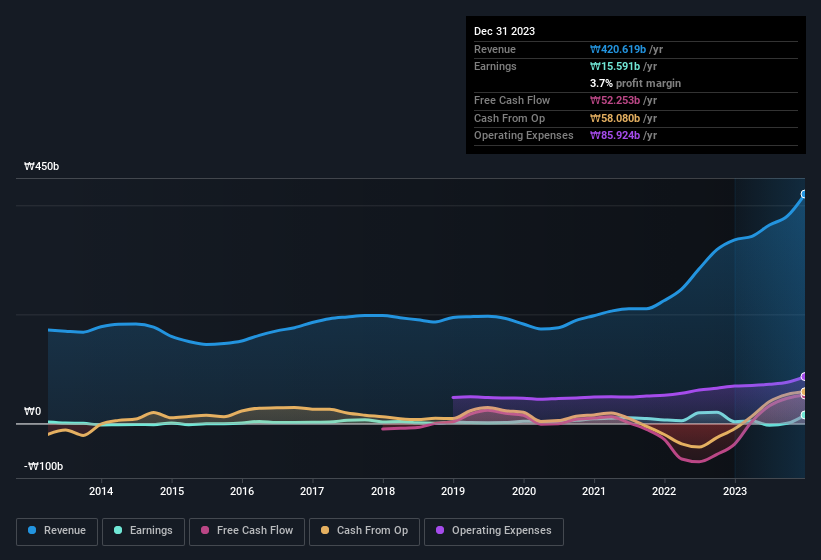- South Korea
- /
- Consumer Durables
- /
- KOSDAQ:A084730
Shareholders Can Be Confident That THINKWARE's (KOSDAQ:084730) Earnings Are High Quality
Even though THINKWARE Corporation's (KOSDAQ:084730) recent earnings release was robust, the market didn't seem to notice. We think that investors have missed some encouraging factors underlying the profit figures.
View our latest analysis for THINKWARE

Examining Cashflow Against THINKWARE's Earnings
As finance nerds would already know, the accrual ratio from cashflow is a key measure for assessing how well a company's free cash flow (FCF) matches its profit. In plain english, this ratio subtracts FCF from net profit, and divides that number by the company's average operating assets over that period. This ratio tells us how much of a company's profit is not backed by free cashflow.
Therefore, it's actually considered a good thing when a company has a negative accrual ratio, but a bad thing if its accrual ratio is positive. While it's not a problem to have a positive accrual ratio, indicating a certain level of non-cash profits, a high accrual ratio is arguably a bad thing, because it indicates paper profits are not matched by cash flow. To quote a 2014 paper by Lewellen and Resutek, "firms with higher accruals tend to be less profitable in the future".
Over the twelve months to December 2023, THINKWARE recorded an accrual ratio of -0.18. That implies it has very good cash conversion, and that its earnings in the last year actually significantly understate its free cash flow. To wit, it produced free cash flow of ₩52b during the period, dwarfing its reported profit of ₩15.6b. Notably, THINKWARE had negative free cash flow last year, so the ₩52b it produced this year was a welcome improvement. Having said that, there is more to the story. We can see that unusual items have impacted its statutory profit, and therefore the accrual ratio.
Note: we always recommend investors check balance sheet strength. Click here to be taken to our balance sheet analysis of THINKWARE.
The Impact Of Unusual Items On Profit
While the accrual ratio might bode well, we also note that THINKWARE's profit was boosted by unusual items worth ₩2.5b in the last twelve months. While we like to see profit increases, we tend to be a little more cautious when unusual items have made a big contribution. We ran the numbers on most publicly listed companies worldwide, and it's very common for unusual items to be once-off in nature. And, after all, that's exactly what the accounting terminology implies. Assuming those unusual items don't show up again in the current year, we'd thus expect profit to be weaker next year (in the absence of business growth, that is).
Our Take On THINKWARE's Profit Performance
In conclusion, THINKWARE's accrual ratio suggests its statutory earnings are of good quality, but on the other hand the profits were boosted by unusual items. Considering all the aforementioned, we'd venture that THINKWARE's profit result is a pretty good guide to its true profitability, albeit a bit on the conservative side. Given that we think the earnings are a decent guide to the business, it might be worth looking at its share price. THINKWARE is growing its earnings, so it wouldn't be surprising if it had an above-average P/E ratio. You can find out by clicking here.
Our examination of THINKWARE has focussed on certain factors that can make its earnings look better than they are. But there is always more to discover if you are capable of focussing your mind on minutiae. For example, many people consider a high return on equity as an indication of favorable business economics, while others like to 'follow the money' and search out stocks that insiders are buying. So you may wish to see this free collection of companies boasting high return on equity, or this list of stocks that insiders are buying.
Valuation is complex, but we're here to simplify it.
Discover if THINKWARE might be undervalued or overvalued with our detailed analysis, featuring fair value estimates, potential risks, dividends, insider trades, and its financial condition.
Access Free AnalysisHave feedback on this article? Concerned about the content? Get in touch with us directly. Alternatively, email editorial-team (at) simplywallst.com.
This article by Simply Wall St is general in nature. We provide commentary based on historical data and analyst forecasts only using an unbiased methodology and our articles are not intended to be financial advice. It does not constitute a recommendation to buy or sell any stock, and does not take account of your objectives, or your financial situation. We aim to bring you long-term focused analysis driven by fundamental data. Note that our analysis may not factor in the latest price-sensitive company announcements or qualitative material. Simply Wall St has no position in any stocks mentioned.
About KOSDAQ:A084730
THINKWARE
Provides location-based and connected services in North America, Europe, Asia, Oceania, and internationally.
Adequate balance sheet and slightly overvalued.
Market Insights
Community Narratives



